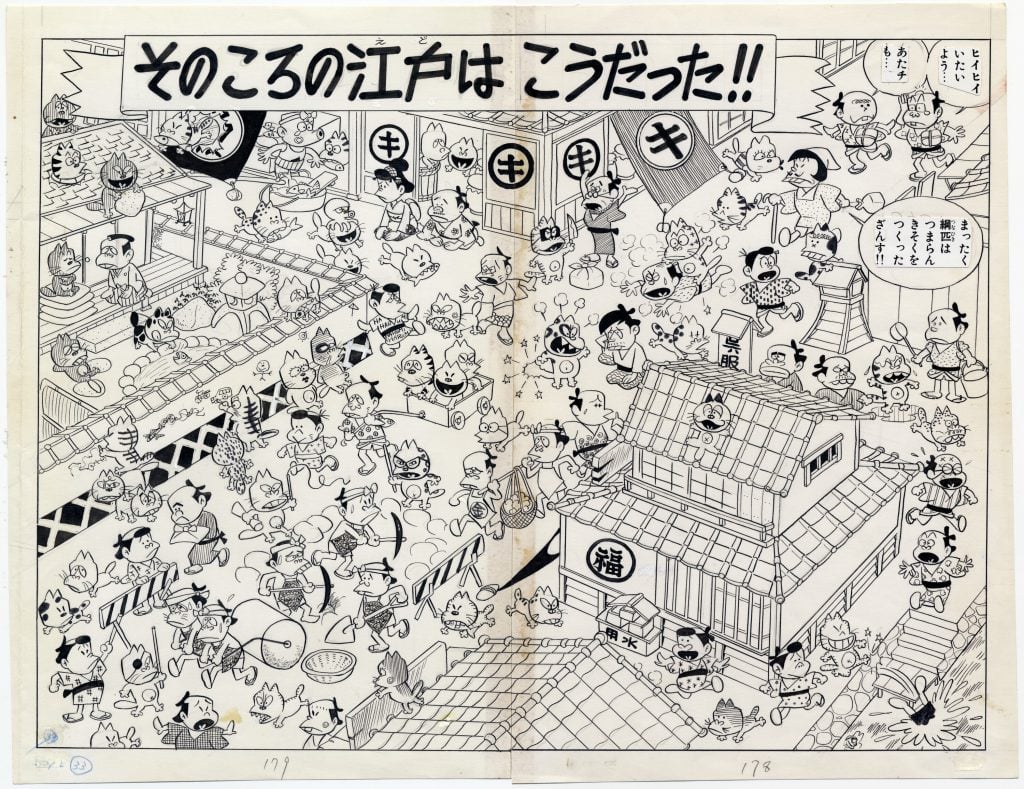Akatsuka Fujio (赤塚不二夫) is widely regarded as one of the pioneers of Japanese gag manga, known for his eccentric humor, outlandish characters, and inventive storytelling. Among his most beloved works is Osomatsu-kun, a series that first debuted in 1962 and quickly became a cultural phenomenon. The series introduced audiences to a cast of quirky characters, most notably the mischievous sextuplet brothers and their flamboyant rival, Iyami, whose signature “Sheeeh!” pose became an iconic part of Japanese pop culture.
In 1965, Akatsuka Fujio created a special installment titled “Edo As It Was!!”, a unique crossover where Iyami takes on the persona of Mito Kōmon, a legendary historical figure from Japan’s Edo period. This creative fusion of comedic manga and historical drama captured the imagination of readers, blending Fujio’s signature humor with elements of classic samurai tales and period settings.
The Context: Akatsuka Fujio and the Rise of Gag Manga
Akatsuka Fujio’s influence in the world of manga is monumental. Born in 1935, he was part of a wave of post-war artists who redefined Japanese comics, transforming them from simplistic children’s entertainment into sophisticated, multifaceted storytelling mediums. Alongside contemporaries such as Osamu Tezuka and Fujiko F. Fujio, Akatsuka carved out a unique niche in comedy manga, popularizing the “gag” genre through exaggerated slapstick, absurd humor, and memorable catchphrases.
Osomatsu-kun, serialized in Weekly Shōnen Sunday, quickly became one of Akatsuka’s most successful works. The manga follows the antics of the Matsuno sextuplets, identical brothers with distinct personalities who find themselves in ridiculous situations. Their interactions with the ever-boastful Iyami, a self-proclaimed gentleman with an exaggerated sense of importance, provided endless comedic potential.
“Edo As It Was!!” – The Historical Parody
The 1965 special, “Edo As It Was!!”, is a playful homage to the Edo period, one of the most culturally significant eras in Japanese history (1603–1868). The story reimagines Iyami as Mito Kōmon, a real-life historical figure who served as a Tokugawa-era official and was later immortalized in Japanese folklore and media.
Iyami as Mito Kōmon
Mito Kōmon is traditionally depicted as a wise and just elder statesman who travels across Japan in disguise, accompanied by loyal retainers, solving injustices and righting wrongs. However, in typical Akatsuka fashion, Iyami’s portrayal is anything but noble. Instead of embodying the dignified presence of Kōmon, Iyami injects his signature arrogance and clumsiness into the role, often complicating the very problems he is supposed to solve.
The story follows Iyami, dressed in traditional Edo attire, as he attempts to uphold the law in various towns, often misinterpreting situations and causing chaos. His exaggerated mannerisms and inability to blend into the historical setting provide the perfect comedic contrast to the stoic Edo-era samurai and commoners.
Recurring Gags and Iconic Moments
One of the highlights of the story is the way it cleverly adapts Iyami’s signature phrase, “Sheeeh!”, into the historical context. Instead of being a modern annoyance, it becomes an exaggerated battle cry or a supposed display of authority, much to the confusion of bystanders.
Fujio’s unique blend of anachronistic humor—mixing Edo-period traditions with Iyami’s flamboyant modernism—results in humorous cultural clashes, such as Iyami trying to introduce 1960s customs into feudal Japan. His obsession with money, his belief that he is far more important than he truly is, and his constant bad luck provide endless entertainment.
Visual Style and Art Techniques
Akatsuka’s art style in “Edo As It Was!!” perfectly balances period accuracy with his trademark cartoonish exaggeration. Characters are often depicted with exaggerated facial expressions, elongated limbs, and highly stylized movements, enhancing the comedic effect.
The background details, however, show a surprising amount of research and effort in recreating the atmosphere of the Edo period. Traditional architecture, clothing styles, and historical settings serve as the backdrop, reinforcing the contrast between Iyami’s over-the-top antics and the otherwise serious tone of feudal Japan.
Cultural Impact and Legacy
The release of “Edo As It Was!!” was met with enthusiasm from fans who enjoyed the fresh take on the beloved characters. The story cemented Iyami’s status as a fan-favorite, and his portrayal of Mito Kōmon became one of the most memorable comedic reinterpretations of the historical figure.
In the years following its release, this special inspired various adaptations and reinterpretations across different media. Osomatsu-kun saw multiple anime adaptations, and Iyami’s “Sheeeh!” pose continued to be referenced in pop culture, television, and even in Japan’s broader comedy scene.
Additionally, the concept of blending Edo-period storytelling with modern humor became a recurring theme in Japanese media, influencing later works that combined historical settings with contemporary satire.
Why “Edo As It Was!!” Still Resonates Today
Even decades after its publication, “Edo As It Was!!” remains relevant due to its timeless humor and sharp social commentary. Akatsuka’s ability to parody both historical and modern Japanese society allows contemporary readers to enjoy the work on multiple levels.
Timeless Characters: Iyami’s overconfidence and absurdity make him a relatable figure, representing human flaws that transcend eras.
Historical Parody: The story provides a humorous lens on Japanese history, making it accessible to younger audiences while still entertaining older fans.
Cultural References: By merging different time periods, the work offers insight into how Japan has evolved socially and culturally.
Akatsuka Fujio’s “Edo As It Was!!” is a brilliant example of how humor can transcend time and culture. By reimagining Iyami as the legendary Mito Kōmon, Akatsuka masterfully combined history and comedy to create a narrative that is both entertaining and insightful.
Whether you’re a longtime fan of Osomatsu-kun or new to Akatsuka’s work, this special serves as a testament to the enduring appeal of his storytelling and the universal nature of comedy. Iyami’s antics as a bumbling historical figure continue to bring laughter to generations, reminding us that sometimes, the most absurd characters leave the greatest impression.
No comments yet.







